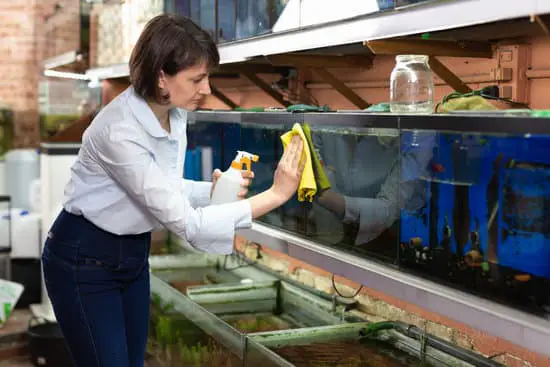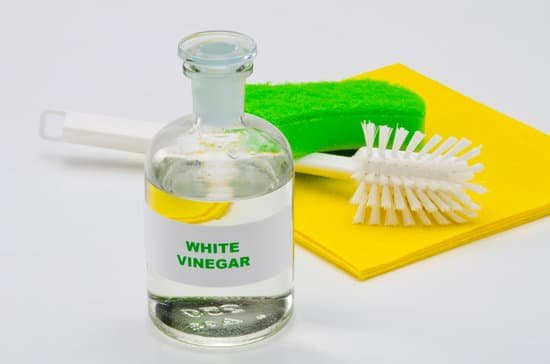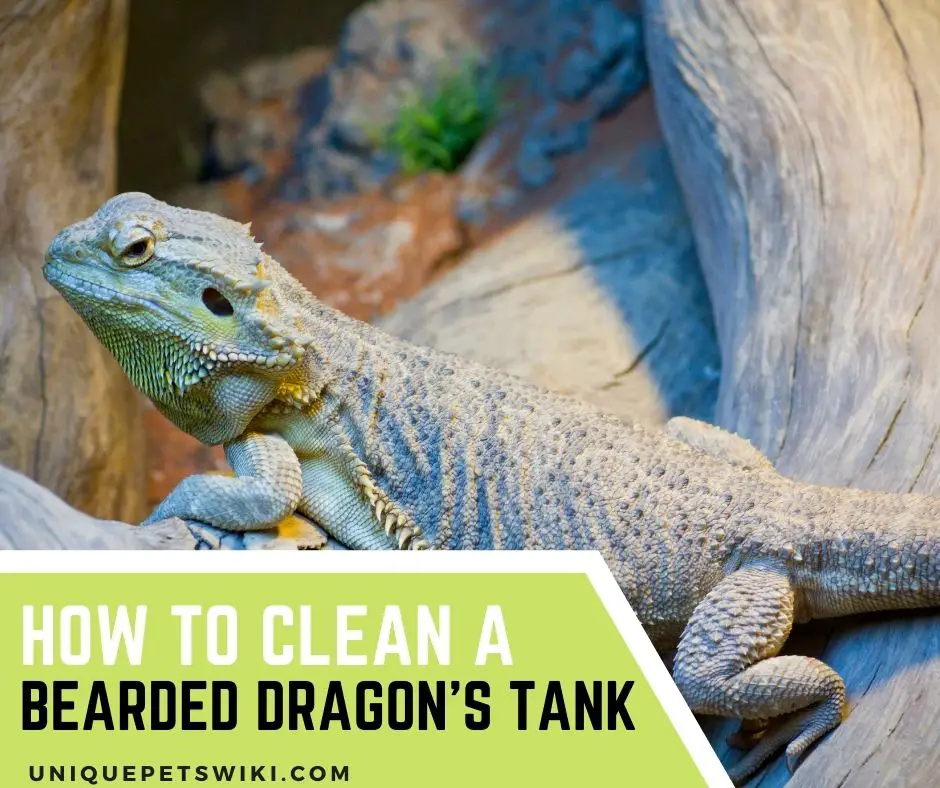Hygiene is imperative for bearded dragons to stay healthy and happy in captivity. Even though you provide the ideal temperature, humidity, lighting, and even provide the best substrate and tank to your bearded dragons, they are still prone to illnesses without proper hygiene. That is why this step-by-step guide on “How To Clean A Bearded Dragon Tank” is a must-read.
There are two types of cleaning your bearded dragon’s cage: the daily routine cleaning and the deep cleaning routine.
Both types are critical, and you should do them in the right way. Unfortunately, many bearded dragon’s owners provide an ideal tank for their pets but fail to observe the proper hygiene.
For this reason, in this article, we will discuss how to clean your bearded dragon’s cage properly. Keep reading.
Contents
- When Do You Need To Clean a Bearded Dragon Tank?
- How To Clean A Bearded Dragon’s Tank: Step By Step Instructions
- Step 1: Prepare the Right Tools and Cleaners
- Step 2: Remove Your Bearded Dragon To Another Place
- Step 3: Unplug Any Electrical Devices And Take Everything Out Of The Tank
- Step 4: Start Cleaning The Substrate
- Step 5: Next, Let’s Clean Inside a Tank And Glass
- Step 6: Wash and Disinfect Accessories or Any Items That Are Going Into the Tank
- Step 7: Install Tank and Get Your Bearded Dragon Back
- Tips And Safety Rules When Cleaning a Bearded Dragon’s Tank
- Last Sentences
When Do You Need To Clean a Bearded Dragon Tank?
Cleaning your bearded dragon’s tank is inevitable for healthy and happy pets. However, to properly clean your bearded dragon’s tank, you must observe daily, weekly, and monthly routines such as picking leftovers and droppings, cleaning food and water dishes, and replacing the drinking water daily.
Also, disinfect the food and water dishes weekly and thoroughly clean the whole tank every month. Negligence in proper cleaning can cause serious health issues such as pest invasion and bacterial infections.
Spot Cleaning: Things that Need to Clean Daily
Daily cleaning routines are quite basic for bearded dragons. They are simple and don’t consume much time. They include
- Picking all food leftovers
- Picking the droppings
- Cleaning the food and water bowls
- Replacing the drinking water
Failure to follow those simple daily routines exposes your bearded dragon to bacterial infections such as salmonella. Unfortunately, this bacteria resides mostly in your bearded dragon’s droppings and can even spread to you.
Things That Need To Clean Weekly
Weekly cleaning involves cleaning the glass surfaces, disinfecting the water and food dishes, and other soiled accessories.
Additionally, you should check for any hidden dead bugs or faeces at the corners of the tank. And, if you are using a carpet as the tank’s substrate, replace and clean the carpet liners with soap and water.
Bearded dragon’s urine can stink a lot. Therefore, weekly cleaning is significant if you want your bearded dragon’s cage to stay fresh and clean.

Deep Cleaning: Things You Need To Clean Monthly
Deep cleaning involves cleaning and disinfecting everything in the bearded dragon’s cage. For good results and maintaining a well-cleaned habitat for your bearded dragon, you will need to:
- Change the substrate
- Use a 5% bleach solution to soak the water and food dishes and then rinse them off with soap and water to remove the bleach.
- Disinfect all the accessories with the 5% bleach and then rinse them off.
- Disinfect the walls and floors by spraying a disinfectant and then eliminating the smell by thoroughly washing them again with soap and water.
- Let the tank dry before returning your bearded dragon.
Things That Need Maintenance or Replace
It is critical to maintaining your bearded dragon’s cage by ensuring that all needed accessories are working efficiently.
Some accessories tend to lose their effectiveness with time. These accessories include:
- UVB bulb
- Lighting bulbs
These three accessories are imperative for providing UVB light and heat for your bearded dragons.
UVB is critical for ensuring that your bearded dragon gets enough Vitamin D that helps with calcium absorption. Without adequate Vitamin D, bearded dragons can suffer from metabolic diseases.
Additionally, bearded dragons require their basking temperature to be high. Thus, you must ensure that the lighting bulb is effective enough to provide a temperature of 100-1050F.
You should replace the UVB and lighting bulbs at least once in 6-12 months, depending on the type of bulb you are using.
How To Clean A Bearded Dragon’s Tank: Step By Step Instructions
Cleaning your bearded dragon’s cage is not a demanding course if you fully understand the steps you need to take.
To make the task easy and effective, you will first require to prepare the items you need to clean and disinfect the tank. These items include disinfectants, sterilizers, water, soap, microfiber cloth, and a brush. Secondly, you will need to remove the bearded dragon from the cage and thoroughly clean everything.
Here are simple steps you should follow to fully clean and disinfect your bearded dragon’s cage.

Step 1: Prepare the Right Tools and Cleaners
Using soap and water, you can brush and clean your bearded dragon’s cage. But, even though it will be clean, it will still have harmful germs such as bacteria, fungi, and viruses.
Therefore, it will be necessary to have disinfectants to kill pathogenic microorganisms and sterilizers to destroy microbial life.
Types Of Cleaning Agents/Solutions For Bearded Dragon Tank
It is necessary to understand that the bearded dragon’s cage needs to be cleaned and fully disinfected.
Multiple microorganisms reside in a bearded dragon’s cage and can cause disease and infections.
To thoroughly get rid of these microorganisms, you will need to use safe disinfectants such as
- Chlorine Bleach
- Hydrogen peroxide
- Vinegar
- F10 Veterinary Disinfectant
- Alcohol
Chlorine Bleach
Chlorine is the most popular as it is readily available in most households. It consists of sodium hydroxide, sodium hypochlorite, and water.
It can kill most microorganisms, and thus it’s quite effective. However, you should not use more than 10% as it can react with other substances, becoming potentially harmful.
Last update on 2022-12-30 / Affiliate links / Images from Amazon Product Advertising API
Hydrogen Peroxide
Hydrogen peroxide is also another oxidizing bleach that is considered safe. However, it is not very effective and thus may require you to use it with other agents such as vinegar.
You should also thoroughly rinse off hydrogen peroxide after use.
Last update on 2022-12-30 / Affiliate links / Images from Amazon Product Advertising API
Vinegar
Vinegar is a suitable cleaning solution that contains acetic acid. It is safe and considerably good for cleaning the glass.
However, it is less effective and can be used at a ratio of 50:50 with water.
Last update on 2022-12-30 / Affiliate links / Images from Amazon Product Advertising API

F10 Veterinary Disinfectant
F10 veterinary disinfectant is a new formula popularly used in veterinary practice. It consists of quaternary ammonium, biguanide compound, and polyhexamethylene biguanide chemicals.
These chemicals are very effective in destroying viruses, bacteria, and other microorganisms.
It is also safe on most substances and thus may not require thorough rinsing after use. However, it is fairly expensive and thus not budget-friendly.
Last update on 2022-12-29 / Affiliate links / Images from Amazon Product Advertising API
Alcohol
Alcohol is common and can effectively kill a wide range of microorganisms. You can use full strength on small objects.
However, it is not suitable for surface cleaning as it highly evaporates and it’s also flammable.
What to Avoid
There are plenty of disinfectants available in the market. But, some can be very harmful to reptiles.
Some of the most harmful disinfectants include
- Pine-sol
- Formaldehyde
- Aldehydes
- Phenols
These chemicals are very toxic to reptiles, and thus you should never use them to disinfect your bearded dragon’s cage.
Supplies to Clean Bearded Dragon’s Cage
Bearded dragons carry salmonella bacteria that can be harmful to humans. Therefore, it would be best to have cleaning tools exclusively used for cleaning the bearded dragon’s items.
These cleaning tools include:
Bucket
You will need a bucket to soak all the accessories such as branches, hiding logs, rocks, artificial plants, water and food bowls.
Latex Gloves
Latex gloves will protect you from scratches and salmonella contamination during handling.
Brushes
You will need medium brushes to clean the surfaces and small brushes like a toothbrush to clean the corners and crevices.
A backup cage
It is difficult to clean the cage with your bearded dragon inside. Thus, you will be required to transfer your bearded dragon to a different cage during the cleaning period.
Antibacterial soap (unscented)
Before you even disinfect the bearded dragon’s cage and accessories, you will need to wash them with antibacterial soap to remove the dirt. The soap should be safe and unscented to prevent leaving a strong smell after cleaning.
Paper Towels
Paper towels will act as temporary substrates until the current substrate dries up.
A Sponge
You will need three sets of sponges: For cleaning, rinsing, and disinfecting.
Hand-Spray Pump
A hand-spray pump will help you spray the disinfectant on the tank’s interiors and when cleaning.

Step 2: Remove Your Bearded Dragon To Another Place
Most cleaning agents have a strong scent and can contain chemicals that affect your bearded dragon.
Therefore, you MUST remove your bearded dragon from its cage before you start the cleaning process.
Besides, it would be difficult to clean the cage with your bearded dragon moving around.
You can use a plastic tub if you don’t have an extra cage to shift your bearded dragon. And, since bearded dragons are semi-arboreal, you must ensure that the tub walls are tall enough to prevent them from escaping.
When picking your leopard gecko from the cage, you must ensure it’s calm and pick it from the front.
Step 3: Unplug Any Electrical Devices And Take Everything Out Of The Tank
The third step would be to unplug any electrical devices and take everything out of the tank.
It is dangerous to work with electric devices as you could cause yourself harm, such as electric shock, if you interfered with live wires.
Besides, since you will be using water to wash off the dirt, leaving the electricity devices unplugged is extremely dangerous.
You will need to clean the tank furniture separately. Thus, removing all accessories and soaking them in a separate bucket is necessary.
Tank furniture refers to rocks, artificial plants, hides, branches, substrate, water and food bowls, and any other item present in the tank.
Removing all the furniture will also help you clean the tank easily and all corners, including crevices.
Step 4: Start Cleaning The Substrate
The substrate is the tank’s flooring or bearded dragon’s beddings. If you use loose substrate such as sand (not the best as it can cause impaction), you will need to wash it thoroughly and then sieve it.
Any other loose substrate will need you to replace it with a new one if it’s not washable.
However, if you are using reptile carpet as the substrate, you will need to thoroughly wash, disinfect, and then dry it before using it again.
Step 5: Next, Let’s Clean Inside a Tank And Glass
The tank’s inside could be messy and smelly. You will need to scrub every corner using a sponge, water, and soap.
Then, it would be best if you rinsed it off, sprayed it with a disinfectant and then rinsed it off again to remove the disinfectant’s smell.
You should ensure to reach every corner and crevice. Also, remember to let the disinfectant stay for 5-10 minutes before rinsing it off to kill all microorganisms completely.
Step 6: Wash and Disinfect Accessories or Any Items That Are Going Into the Tank
After the tank’s interior is clean, it’s now time to scrub the accessories you had soaked earlier.
After they are well cleaned, you should spray or soak them in a disinfectant and let them sit for at least 5-10 minutes.
Then, you should rinse off the disinfectant thoroughly as it can be toxic to your bearded dragon.
Additionally, disinfectants have a strong smell that can affect your bearded dragon.
And, if you don’t want to use disinfectants to kill germs, you could also use a steamer that uses 200-3000 as it also kills all microorganisms present.
Step 7: Install Tank and Get Your Bearded Dragon Back
The last step would be installing the tank and getting your bearded dragon back. It is necessary to set up the tank as before for the bearded dragon to assimilate easily.
Change in a setup can make your bearded dragon feel like it’s in a new environment making it feel stressed.
Also, remember to replace any tank accessory fully depreciated with new ones.
Tips And Safety Rules When Cleaning a Bearded Dragon’s Tank
- Make sure the tank is fully dry before returning your bearded dragon. Dump accessories and tanks can grow molds, and will help fungi thrive easily in the tank.
- Ensure that the tank is free from the disinfectant smell as it can be toxic to your bearded dragon.
- Replace any worn-out furniture with new ones
- Don’t use the same sponge to disinfect and rinse the tank or furniture. Instead, use a different set for every step.
Last Sentences
Cleaning bearded dragon’s cages is essential to keep them happy and healthy. While physical cleaning can remove infectious and organic matters, disinfecting helps to kill germs and all microorganisms.
However, overuse of disinfectants can be harmful to bearded dragons and the environment.
Therefore, you should read the instructions and use any chemical substance as required.
If you have been wondering how to clean your bearded dragon cage, we hope this article gives you courage and motivation. Good luck with your bearded dragon.








